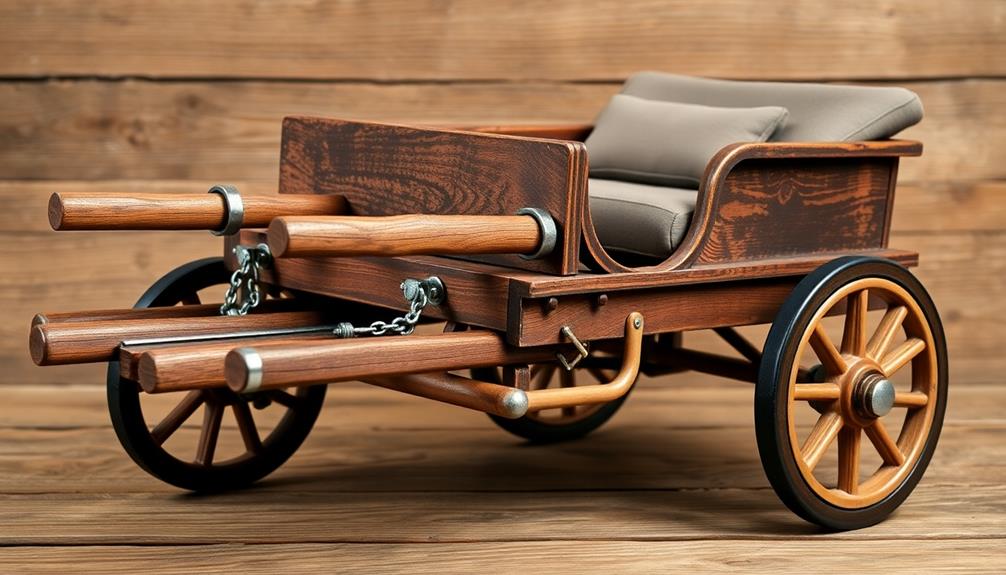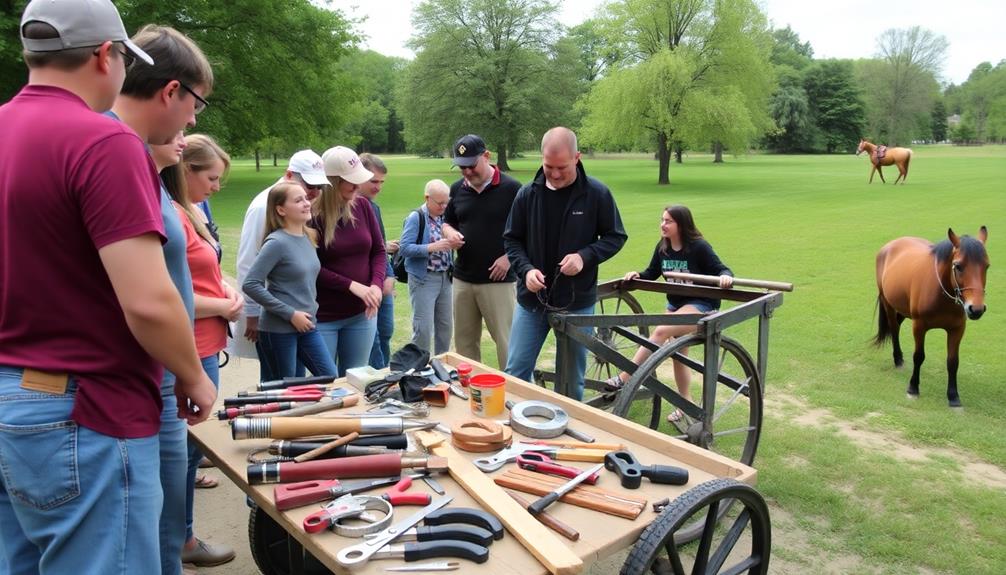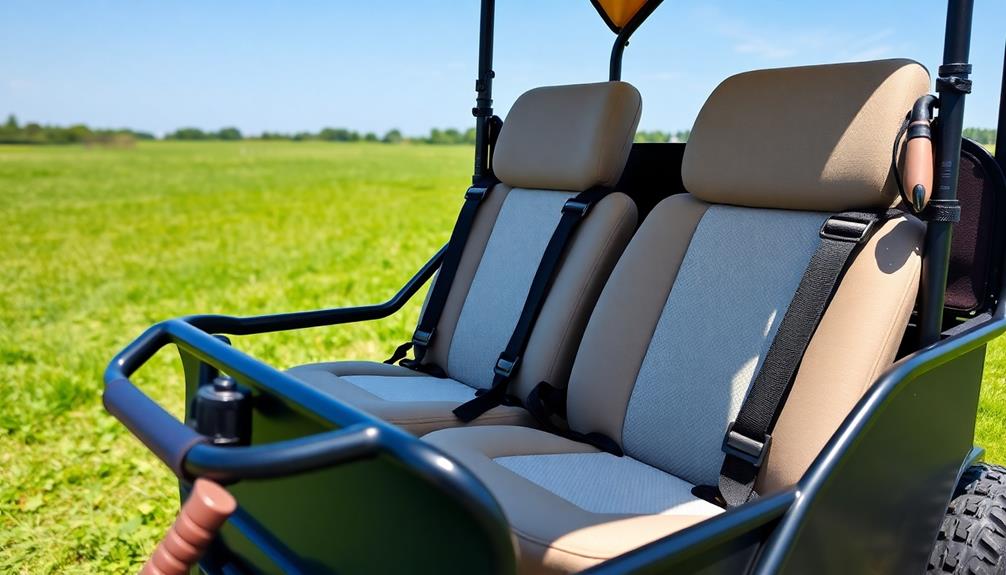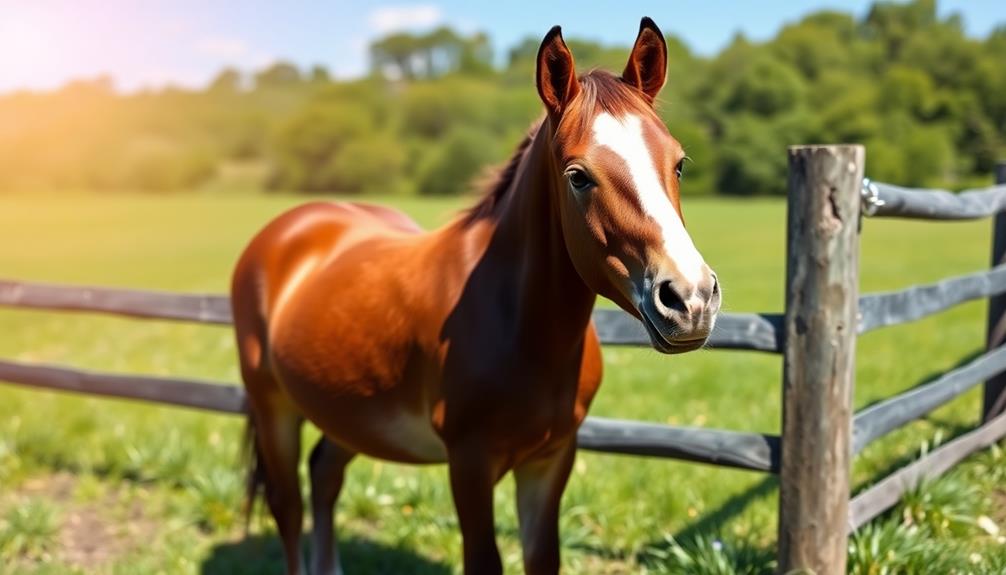When it comes to miniature horse carts, you need specific parts for a smooth ride. Start with the shafts, making certain they suit your pony's size. Larger pneumatic wheels enhance comfort, while a good suspension system absorbs shocks. Don't skip the singletree; it's crucial for efficient weight distribution. Regular maintenance keeps everything in top shape—check spokes and bolts often. Plus, consider customization options like memory foam cushions for better support. With proper sizing and the right components, you'll guarantee a delightful experience for both you and your pony. There's a lot more to discover about optimizing your ride experience!
Key Takeaways
- Choose appropriate shafts and wheels that match your pony's size for optimal stability and comfort during rides.
- Select a suitable suspension system, such as C springs or shock absorbers, to enhance ride smoothness and performance.
- Regularly inspect and maintain cart components, focusing on wheels, spokes, and bolts to ensure safety and longevity.
- Customize with memory foam cushions and padded armrests for improved comfort during extended driving sessions.
- Engage with community resources for expert tips on modifications, maintenance, and best practices for miniature horse cart ownership.
Essential Cart Components

When it comes to miniature horse carts, understanding essential components is crucial for safe and enjoyable driving. The shafts are one of the most critical parts, as they should match your pony's size perfectly. A proper fit guarantees comfort and stability for both you and your horse.
Equally important are the wheels; opting for larger pneumatic tires can greatly enhance your ride quality. These tires offer better shock absorption and are ideal for traversing rough terrains.
Another key component is the suspension system. Whether you choose C springs or elliptical springs, these systems help absorb shocks and provide a smoother ride, making the experience more pleasant for both you and your horse.
Additionally, a sturdy singletree is necessary for connecting the cart to the harness, ensuring efficient weight distribution and easy maneuverability.
Lastly, don't overlook the importance of regular maintenance. Keeping an eye on components like spokes, welds, and springs is crucial for maintaining your cart's structural integrity and performance.
Choosing the Right Suspension

Selecting the right suspension for your miniature horse cart can make all the difference in your driving experience. A well-chosen suspension system enhances ride comfort, allowing you and your horse to navigate various terrains smoothly. You might consider options like C springs or single elliptical springs, which provide excellent support and cushioning.
Here are some key factors to keep in mind when choosing your suspension:
- C Springs: These offer a good balance of comfort and durability.
- Single Elliptical Springs: Ideal for rough terrain, they guarantee a smoother ride.
- Shock Absorbers: Motorcycle shock absorbers in swing arms can considerably improve performance.
- Frey Carriage Company Kits: Known for reducing bounce and enhancing ride stability.
Proper installation and alignment of these components are essential for safety and efficiency.
A combination of coil springs and C springs often yields the best results, providing a comfortable ride while maintaining durability.
Wheel and Tire Options

When you're choosing wheels and tires for your miniature horse cart, consider how tire types and sizes impact your ride quality.
Larger wheels can enhance comfort over rough terrain, while the right tire material affects both durability and shock absorption.
Understanding these factors will help you create a smoother experience for both you and your pony.
Tire Types Explained
Understanding the various tire types is essential for ensuring a smooth and safe ride in a miniature horse cart. Your choice will impact comfort, durability, and performance.
Two primary tire types are solid rubber and pneumatic tires, each with unique benefits.
- Pneumatic Tires: These air-filled tires provide a smoother ride, making them ideal for uneven terrains. However, they require regular inflation and can be susceptible to punctures from sharp objects.
- Solid Rubber Tires: While these tires are more durable and resistant to flats, they offer a harder ride, which may be less comfortable on rough surfaces.
- Terrain Considerations: Think about where you'll be riding. Wider and taller tires often provide better stability and traction on uneven ground.
- Enhancing Durability: If you opt for pneumatic tires, consider adding anti-puncture strips or sealant fluids in areas with high debris to reduce flat risks.
Wheel Size Considerations
The size of the wheels on your miniature horse cart plays a significant role in your overall riding experience. Generally, wheel sizes range from 20 to 26 inches, and choosing the right size affects not just ride quality but also maneuverability and stability.
Larger wheels, typically 24 inches or more, excel in shock absorption, providing a smoother ride over uneven terrain.
While pneumatic tires can enhance comfort, they need regular inflation and can be prone to punctures. On the other hand, solid rubber tires offer durability and less maintenance but may give you a harsher ride.
Think about your needs: if you're traversing rough landscapes, a larger wheel size with wider tires can improve grip and stability.
Matching your wheel size with the cart's design and the weight of the load being pulled is vital for performance and safety.
Narrower tires might increase speed, but they can compromise comfort, so consider what matters most for your rides. Balancing these factors will help you make an informed decision for your miniature horse cart.
Impact on Ride Quality
Choosing the right wheel and tire options for your miniature horse cart can greatly enhance your ride quality. The combination of wheel size and tire type can make a noticeable difference in how comfortable your journey will be.
For instance, opting for larger wheels, like 24 inches, can help absorb bumps better than smaller 21-inch options.
Pneumatic tires are another excellent choice, as they provide a smoother ride by absorbing shocks, while solid rubber tires may lead to a harsher experience on uneven surfaces.
Here are some key considerations to keep in mind:
- Wheel Size: Larger wheels improve comfort and stability.
- Pneumatic Tires: They enhance ride quality by reducing shock.
- Wider Tires: They distribute weight effectively for better traction.
- No-Flat Options: These tires are reliable for long-distance travel, minimizing flat risks.
Sizing Your Pony Cart

Getting the right size for your pony cart is essential for your pony's safety and comfort. Proper sizing helps prevent strain during driving, ensuring a smooth experience for both you and your pony. To determine the best fit, consider key dimensions of your pony, such as girth, chest, back length, and stifle width.
| Pony Size | Recommended Shaft Length |
|---|---|
| Miniature Pony | 49-55 inches |
| Regular-Sized Pony | 60 inches |
| Girth Measurement | Measure around the belly |
| Chest Measurement | Measure across the chest |
| Back Length | Measure from withers to tail |
Avoid attaching full-sized horses to pony carts, as they're specifically designed for miniature horses or small ponies. Additionally, keep in mind that cart stability can vary; two-wheel carts may be less stable compared to four-wheel carts. Ensuring the proper sizing of your pony cart not only enhances your pony's comfort but also contributes to a safe and enjoyable ride. Take the time to measure and choose wisely—your pony will thank you!
Community Support and Resources

In a world where miniature horse enthusiasts thrive, community support and resources play an essential role in enhancing your experience. By engaging with fellow owners, you can gain insights and tips that make a significant difference in your journey. Online platforms and local driving clubs are invaluable for building connections and sharing knowledge.
Here are some resources you shouldn't miss:
- Community Forums: Connect with other owners to discuss modifications, maintenance tips, and troubleshooting.
- Driving Clubs: Join local clubs for recommendations on cart suppliers and maintenance services, fostering meaningful relationships with fellow enthusiasts.
- Social Media Groups: Use platforms like Facebook to buy, sell, and discuss miniature horse carts and their parts, expanding your network.
- Experience Sharing: Benefit from the wealth of knowledge shared by community members about cart performance and innovative solutions.
Staying engaged in these communities not only keeps you updated on best practices but also helps you find support and advice tailored to your needs.
With the right connections, you'll enhance your ride quality and overall experience.
Maintenance Tips for Longevity

To guarantee your miniature horse cart lasts for years, regular maintenance is key. Start with a thorough inspection of the wheels and spokes. Look for any signs of wear or damage; your safety depends on it.
Proper shaft alignment is essential too. Make certain they return to their original shape after use to prevent strain on your horse.
Next, don't forget to check and tighten all bolts and connections periodically. This simple maintenance tip can greatly maintain the structural integrity of your cart and help prevent accidents while driving.
You should also clean and lubricate moving parts, like axles and bearings. This reduces friction and prolongs the lifespan of your cart components, guaranteeing a smooth ride every time.
Customization for Comfort

To enhance your driving experience, consider upgrading to memory foam seat cushions that provide better support and weight distribution.
Adding padded armrests can also minimize strain on your arms and shoulders, making those longer rides much more enjoyable.
Customizing these features guarantees that you and your mini horse enjoy every journey in comfort.
Seat Cushioning Options
When it comes to enhancing comfort in your miniature horse cart, selecting the right seat cushioning options can make all the difference. A well-cushioned seat not only improves your experience but also guarantees a better ride for everyone involved.
Consider these options to maximize your seating comfort:
- Memory Foam: This popular choice conforms to your body, providing excellent support during rides.
- Foam Combination: Mixing high-density foam with gel padding balances firmness and softness for ideal comfort.
- Heavy Denim Covers: These protect your vinyl seat while adding an extra layer of cushioning and durability.
- Ergonomic Positioning: Adjusting seat height and tug placement is vital for maintaining proper posture while driving.
Armrest Enhancement Features
Adding armrests to your miniature horse cart can greatly enhance your driving experience, providing essential support during those long rides. Padded armrests notably improve comfort by reducing strain on your arms and allowing for a more relaxed posture. Customization options, such as adjustable height and angle, cater to your individual preferences, guaranteeing ideal ergonomics.
| Feature | Benefits |
|---|---|
| Padded Armrests | Increased comfort |
| Adjustable Height | Personalized fit |
| Cup Holders | Convenient beverage storage |
| Weather-Resistant Materials | Longevity and easy maintenance |
Incorporating storage options not only boosts functionality but also keeps your essentials within reach. Durable, weather-resistant materials guarantee that your armrests withstand outdoor conditions, making them a smart investment. Properly designed armrests can promote better posture, leading to a safer and more enjoyable driving experience. So, when you're looking to enhance your miniature horse cart, consider the addition of customizable armrests for that perfect blend of comfort and functionality. You'll appreciate the difference during those long rides!
Frequently Asked Questions
What Is Needed for a Mini Horse?
For your mini horse, you'll need a properly sized harness, a lightweight cart, and comfortable padding. Guarantee the cart's shafts fit well, allowing for smooth movement and safety during your drives together. Enjoy the ride!
What Size Cart for a Miniature Horse?
Choosing the right cart for your miniature horse is like finding the perfect pair of shoes. For ponies under 3 feet tall, look for carts with shafts between 49-55 inches to guarantee a comfortable, safe ride.
How Heavy of a Cart Can a Mini Horse Pull?
A mini horse can safely pull a cart weighing 20-25% of its body weight. So, if your horse weighs 300 pounds, aim for a cart that's no more than 75 pounds, including any extra cargo.
Are Miniature Horses High Maintenance?
"You reap what you sow." Miniature horses aren't high maintenance compared to full-sized ones, but they still need regular hoof care, a balanced diet, vet check-ups, exercise, and grooming to stay healthy and happy.
Conclusion
To summarize, equipping your miniature horse cart with the right parts can make all the difference for a smooth ride. Did you know that properly maintained carts can last up to 20 years? By investing in quality components and regular upkeep, you'll not only enhance your pony's comfort but also guarantee many joyful rides together. So, gear up, stay informed, and enjoy the journey with your beloved mini!










